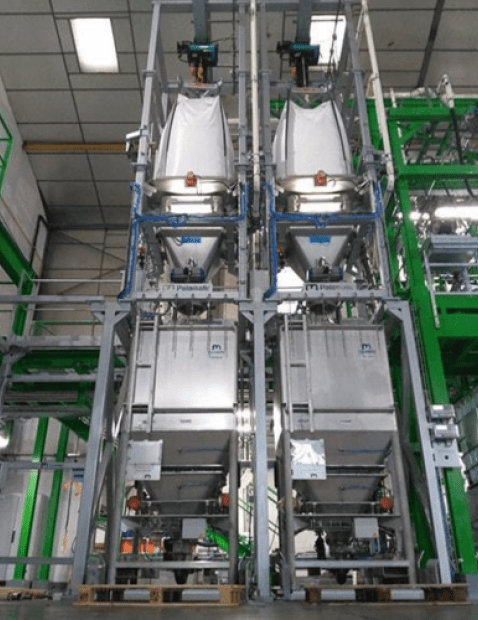Palamatic Process supports you in the design of your installations dealing with explosive powders. In this document, you will find an ATEX guide for equipment that complies with industrial process regulations.
1. Main causes of explosion
1. Presence of oxidant
Mainly oxygen in the air (O2 is "oxygen" for chemists) but also other gases such as Di-chlorine (Cl2), Nitrogen Dioxide (NO2), Nitrogen Trifluoro-mide (NF3)...
2. Presence of fuel
A flammable substance that can be: a gas (methane, acetylene, etc.), a liquid (gasoline, solvent, etc.) or a solid (sulfur, wood, sugar, flour, etc.), generally speaking, all organic powders.
NB: mineral type powders do not present any risk.
3. Special form of fuel
- Gas (methane, acetylene, butane, propane, hydrogen, etc.)
- Steam (gasoline, ethyl alcohol, solvent, acetone, etc.)
- Dust (wood, sugar, grains, starch, aluminum, etc.)
4. Explosive range
To be explosive, the mixture must be neither too poor nor too rich in fuel.
- LEL: the Lower Explosive or Flammable Limit (LEL or LII) of a gas or vapor in air, is the minimum volume concentration in the mixture above which it can be ignited. - source: ED911 from INRS
- UEL: the Upper Explosive or Flammable Limit (UEL or UFL) of a gas or vapor in air is the maximum concentration by volume in the mixture below which it can be ignited. - source: ED911 from INRS
To be explosive, the mixture with air must meet the following condition: LEL< concentration of the flammable substance in the mixture < UEL.
Accuracy concerning dusts: "The minimum and maximum explosive concentrations of dusts are not known as precisely as those of gases".
5. Sufficient containment
In the absence of a containment enclosure, in a dust cloud that has just been ignited, the atmosphere consists of 2 parts:
- The rear front contains partially burnt gas and solid residues.
- In front unburnt dust is present.
This process creates a fireball. This "mixture" must be in a containment enclosure. In fact, we see the appearance of an pressure due to the combustible gas driving out the air which can lift the dust. The flame will then ignite the dust in the air which can occur as long as dust is present.
6. Source of ignition
- Electric (sparks, heating, etc.)
- Electrostatic discharges
- Temperature rise (e.g., hot surfaces)
- Thermal (open flames, cigarettes, hot surfaces, etc.)
- Mechanical (sparks, heating, etc.)
- Chemical (exothermic reaction, self-heating, etc.)
- Bacteriological (bacterial fermentation that can heat the medium and create self-heating conditions)
- Climate (lightning, sun, etc.).
Auto-ignition temperatures obtained with the IEC 1241-25-1 method:
| Dust (granulometry) (Media value, μm) |
Temp. ignition point of cloud at the Godbert oven - Greenwald (°C) |
Temp. ignition deposit of dust layer 5 mm (°C) |
|---|---|---|
| Starch (52) Cereals (50) Charcoal (28) Copra (510) Wood flour (65) Milk powder (60) Corn (550) Corn (28) Soybean flour (20) Sugar (30) Tobacco (65) |
350 520 600 470 490 610 780 440 620 490 450 |
345 300 250 290 340 340 410 280 280 480 300 |
Identify the potential sources of ignition:

| Location | Type de zone | Notes |
|---|---|---|
| Internal volume of the pipes of the conveying network | Zone 20 | This classification corresponds to the case where the flow of dusty air constitutes an explosive atmosphere |
| Internal filter volume, dusty air side | Zone 20 | |
| Internal filter volume, clean air side | Zone 22 | Depending on the effectiveness of the cleaning of the premises, remove the deposits |
| Volume of the room in which the filter is installed | Zonne 22 or unclassified |
2. Devices for surface industries (Group II)
| Zone | 0 | 20 | 1 | 21 | 2 | 22 |
|---|---|---|---|---|---|---|
| Nature of the atmosphere |
G Gas |
D Dust |
G Gas |
D Dust |
G Gas |
D Dust |
| Explosive atmosphere | Permanent presence | Intermittent presence | Episodic presence | |||
| Category of appliances that can be used according to 94/9/CE | 1 | 2 | 3 | |||

3. Gas groups
| Group | Gas reference | IEMS (mm) | EMI (mj) |
|---|---|---|---|
| I | Méthane | 1.14 | 0.28 |
| IIA | Propane | 0.92 | 0.25 |
| IIB | Ethylene | 0.65 | 0.07 |
| IIC | Hydrogen/Acetylene | 0.37 | 1.011/0.017 |
IEMS: Maximum Experimental Interstice of Security
EMI: Minimum Inflammation Energy
IIB1 : IEMS > 0.85
IIB2 : IEMS > 0.75
IIB3 : IEMS > 0.65

If your require further assistance,
I am at your entire disposal.
Loïc, expert in powders
4. Dust groups
| Groups | Type dof dust | Cut | Resistance |
|---|---|---|---|
| IIIA | Combustible particles in suspension | > 500 μm | - |
| IIIB | Non conductive dust | ≤ 500 μm | > 10³ Ω.m |
| IIIC | Conductive dust | ≤ 500 μm | ≤ 10³ Ω.m |
5. Temperature classes (maximum temperatures)
| Gas | T1 (450) | T2 (300) | T3 (200) | T4 (135) | T5 (100) | T6 (85) |
|---|---|---|---|---|---|---|
| Powder | 450 | 300 | 200 | 135 | 100 | 85 |
6. Indices de protection (IP)
| Protection against solid bodies | ||
|---|---|---|
| 0 | No protection | |
| 1 |
 |
Protected against solid objects ≥50 mm (e.g. involuntary hand contact) |
| 2 |
 |
Protected against solid bodies ≥12 mm (e.g., fingers) |
| 3 |
 |
Protected against solid bodies ≥2.5mm (e.g., screw tools, etc.) |
| 4 |
 |
Protected against solid objects ≥1 mm (e.g., fine tools, small wires) |
| 5 |
 |
Protected against dust (no harmful deposits) |
| 6 |
 |
Totally protected against dust |
| Protection against liquid bodies | ||
|---|---|---|
| 0 | No protection | |
| 1 |
|
Protected against vertically falling drops of water |
| 2 |
|
Protected against falling water inclined at 15 ° |
| 3 |
|
Protected against rainwater up to 60 ° from vertical |
| 4 |
 |
Protected against splashing water from all directions |
| 5 |
|
Protected against jets of water from all directions |
| 6 |
|
Protected against water jets and heavy seas from all directions |
| 7 |
|
Protected against the effects of immersion |
| 9 |
 |
Protected against the effects of prolonged immersion under specified conditions |
7. The explosive characteristics of powders
To consult the characteristics of explosive powders, consult our article.
PMAX: maximum explosion pressure, maximum pressure (generally measured in relation to atmospheric pressure) reached in a closed tank during the explosion of the most reactive oxidizer / fuel mixture.
KST: dust explosion coefficient, maximum rate of rising pressure, multiplied by the cubic root of the volume of the container, during explosion tests of the most reactive oxidizer / fuel mixture.
EMI: explosive atmosphere, mixture of flammable gases, vapors, or dust in air.
LEL: lower explosive limit, minimum concentration of gas or dust in the air below which there can be no explosion.
GRANULOMETRY: average diameter of dust particles, usually measured using a laser particle size analyzer, or determined by sieving. The risk of explosion is considered when the particle diameter is less than 300 microns.
TMI Cloud / Dust: The auto-ignition temperature or auto-ignition temperature is the lowest temperature at which the substance ignites when mixed with air under the conditions defined in the test method without any other input of energy as flame or spark. Unit: ° K
Palamatic Process can assist you in analysing your risks and proposing equipment that is suitable for your powders and processes under ATEX atmosphere. Our experts are certified in accordance with the current regulations. Contact us for more information!




















